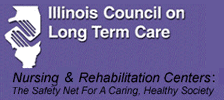|

April 3, 2001
Legislative Initiative Corrects
Imbalance in Medicaid System
Rates Haven’t Kept Pace with Costs
CHICAGO — Residents living in nursing
homes today have more complex care needs than ever before,
needs that demand advanced treatment. Outdated Medicaid
reimbursement rates, which haven’t been properly adjusted
in seven years, are leaving nursing homes struggling
to cover the new costs.
Illinois Senate Bill 608 will rectify
the widening disparity between nursing home costs and
the Medicaid funding reimbursements given to homes.
The plan proposed in SB 608 calls for updating the data
to 1999 figures, the most recent on file. Nursing homes
risk cutting services if Medicaid reimbursements are
not brought in line with the costs of the care.
"This initiative is about continuing
to provide quality care for our residents," said
Terrence Sullivan, executive director of the Illinois
Council on Long Term Care, a professional organization
representing 210 nursing homes and one of four major
supporters of SB 608. "Updating the reimbursements
will allow facilities to continue to attract and retain
quality staff, provide effective health care treatments
and meet the daily needs of Illinois residents living
in nursing homes."
Since 1994 average costs at Illinois
nursing homes have increased 49 percent but Medicaid
rates have increased only 29 percent. This difference
is the result of advances in care treatment and technology,
and an administrative "freeze" of the rates
implemented in January 1994. The current Medicaid reimbursement
rates are based on cost reports from 1992 and resident
assessment data from 1993. The cost of living adjustments
that have been added to the rates have not met the costs
of providing the high-tech and advanced care required
to treat current residents.
The coalition that supports this
legislation is made up of the state’s four largest professional
nursing home associations – the Illinois Council on
Long Term Care, Illinois Health Care Association, Life
Services Network of Illinois and the County Nursing
Home Association – as well as the state’s largest nursing
home employee union – the Service Employees International
Union, Local #4. Together they represent more than 54,000
professionals and caregivers serving 73,000 nursing
home residents. The Catholic Conference, Community Bankers
Association and Metro Counties Association also support
this legislation.

Editor’s note: This chart illustrates
the average daily costs for Illinois nursing homes versus
the average Medicaid reimbursement. Original and digital
versions of this chart are available for publication.
|

